Newborn husky puppies: description and care
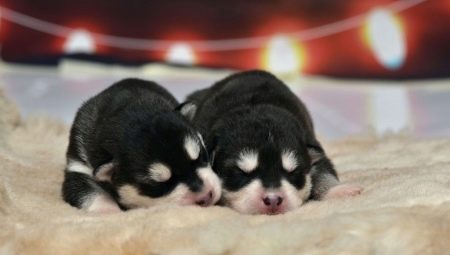
Newborn husky puppies look cute and literally eye-catching. Babies weigh only 350-500 g. This directly depends on the number of puppies in the litter and the gender of a particular individual. Very soon after birth, the characteristics of the breed begin to appear.
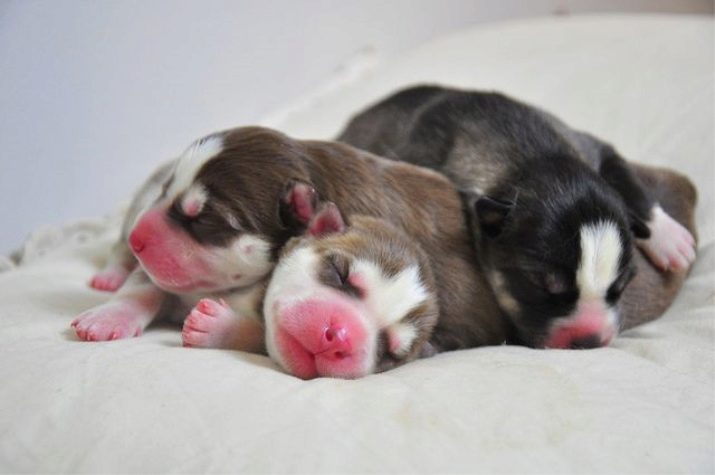
Husky active, real working dogs. Perfect for owners who are in constant motion. But at the same time, the dogs must be provided with proper care.

How do they grow and develop?
The first look at the puppy is delightful. Babies with closed eyes, thick paws and covered mainly with white hair with a few distinctive spots.
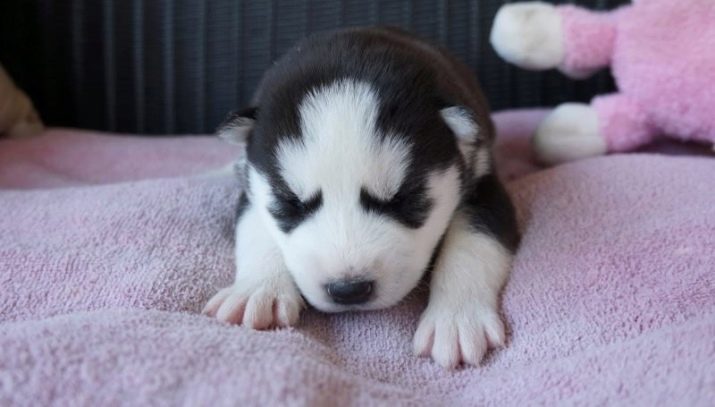
The development of puppies is as follows.
- 15 days after birth, the weight of the individual increases 3 times, or even more. By the end of the first month of life, the animal grows up to 24 cm at the withers with a weight of up to 3 kg 700 g.
- By the second month of life, the puppy moves well without the help of people, is excellently built. The ears are just starting to rise. During this period, babies are actively gaining weight, average indicators: 7.5 kg at 32 cm at the withers.
- At 3 months it's time to transfer the puppy to five meals a day, which leads to the next phase of active growth.Individuals reach 40 cm at the withers.
- Already at 4 months, the husky begins to enter adolescence. This period is characterized by rapid growth and active weight gain (46 cm at 18 kg). The puppy looks more and more like an adult dog.
- The lines continue to form in 5 months. Normally, the indicators of weight and height increase to 23 kg and 50 cm, respectively.
- At 6 months, the dog is already quite heavy (weighs about 25 kg) and large (about 54 cm at the withers). However, the puppy is still far from an adult.
- At 7 months old, it becomes very difficult to distinguish a puppy from an adult dog. Weight increases during this period by about 3 kg, and growth may not change.
- At 8 months, growth slows down even more. Weighing 30 kg, the height at the withers is about 58 cm.
- At 9 months, the height does not change, this is already an indicator of an adult. Weight can reach 33 kg.
- With careful care, a puppy weighs 35 kg at 10 months, this is the average norm for an adult. Growth doesn't change anymore.
- At 1 year old, the puppy ceases to be such and belongs to the number of adult animals. Males can weigh up to 40 kg. Height usually does not exceed 60 cm at the withers.
Husky is considered a large breed, the dog develops for a relatively long time. After birth, puppies of both sexes up to 6 months of age develop almost the same. However, in girls, active growth continues up to 8 months. The size of the dog can vary up to 1 year and is finally formed by 2 years of age. Males are in the phase of active growth up to 9 months, develop up to 1.5 years and form finally until the age of 2 years 3 months.
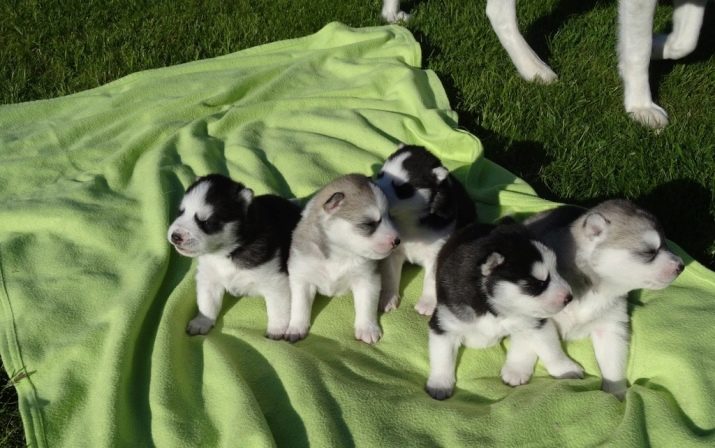
About eyes
With proper development and the absence of pathologies, puppies open their eyelids on the 11-16th day of life. It happens that only one eye opens, or both, but half. This is considered the norm. After a couple of days, the baby's vision is no different from that of adults. If the eyelids do not rise within 1 month after birth, you must urgently contact your veterinarian.
Interestingly, the dog's eye color can change. Most small huskies are blue-eyed. During the first 6 months of life, the color may change.
This breed is characterized by a phenomenon in which the eyes differ from each other.

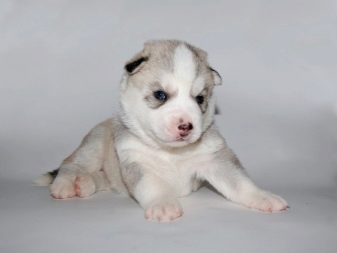
Change of teeth
Huskies are born completely without teeth. During the first 3 months of life, all dairy products appear. Over time, milk teeth fall out, and molars grow in their place. The replacement takes place before the seventh month. Already at 9 months, a puppy should have 42 molars.
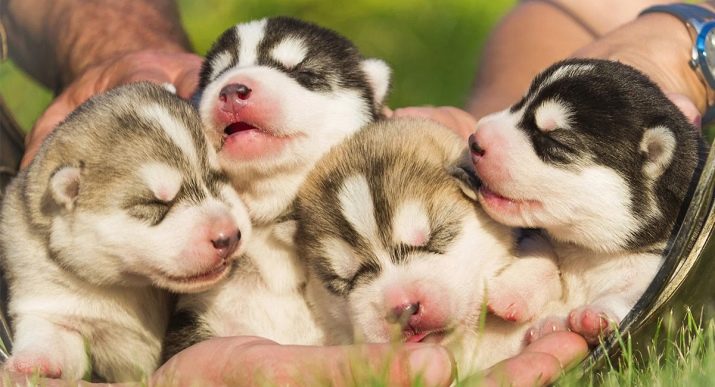
Care features
After the puppies are born, it is better to take a vacation, they will need a lot of your attention. This is especially important if the bitch is giving birth for the first time. If you are planning to breed huskies, then notice all the slightest changes in the mother's behavior, this is important.
If the bitch is already experienced and the delivery went well, then the puppies will not cause much trouble.
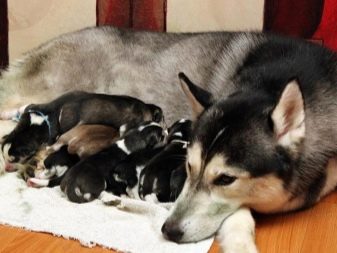

At birth, little huskies already have a number of necessary reflexes, and mothers, in turn, have a strong maternal instinct. If the birth is not the first, then the bitch herself will carefully look after the babies, and you will just need to help her a little. Mothers calmly feed and lick puppies, protect from dangers. Blind and clumsy babies are great at finding mother's nipples.
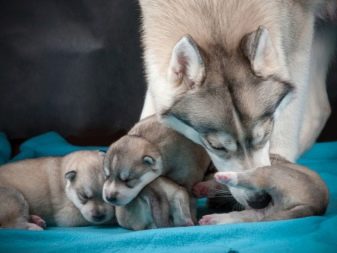
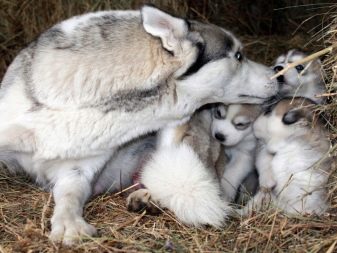
It is important that feeding takes place within the first couple of hours after birth. Colostrum is rich in vitamins, useful microelements. After you guide the babies, they will find the nipple themselves and begin to massage the area around it with their paws. This is as it should be, these movements stimulate the production and supply of food.
It is the first milk that provides children with good immunity and protection against primary infectious diseases.

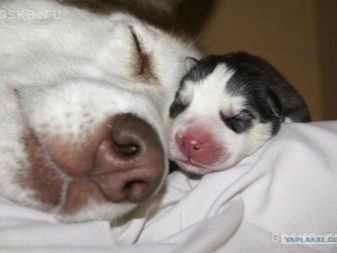
In the first days of life, babies only sleep and eat. If they do not squeak, then they are full. You cannot take babies away from mom. At first they cannot be emptied, so the bitch licks each of them carefully. All secretions are eaten by the mother, so the litter remains dry and clean in place.
See the next video for caring for newborn husky puppies.






































